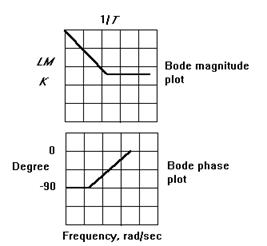
The primary function of the proportional-integral (PI) compensator is to increase the low frequency gains to reduce steady-state errors and decrease sensitivity to noise and parameter variations.
Transfer function

Bode plots

To design a PI compensator
Because the function of the PI compensator is to increase low frequency gain, the design steps differ from those for the previous two compensators.
1. Determine the frequency (ω*) that defines the region ω < ω* in which the gain is to be increased.
2. Determine the amount of gain to be added (K*) using the error coefficient specifications for the system.
3.
Identify the cross-over frequency and phase margin from the uncompensated system
Bode plots,  and
and  .
.
4.
Select the zero of the PI compensator to satisfy the steady-state error
specifications. If, however, a phase margin problem exists (for example, the
phase margin is less than 30 degrees), do not allow it to move past  .
.
5. Initially select K = 1 and tune the compensator slightly by modifying the value of K for the desired performance.